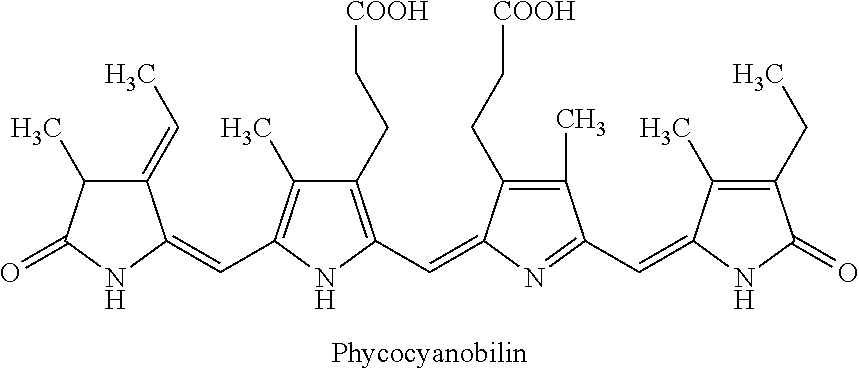Meso-biliverdin compositions and methods
a technology of biliverdin and composition, applied in the field ofmesobiliverdin, can solve the problems of high cost and difficulty in production of biliverdin ix and other biliverdin isomers
- Summary
- Abstract
- Description
- Claims
- Application Information
AI Technical Summary
Benefits of technology
Problems solved by technology
Method used
Image
Examples
example 1
Cyanobacteria Production
[0033]Arthrospira platensis was grown on produced water that has been previously shaken for several days to eliminate volatile gases and supplemented with sodium nitrate and potassium phosphate. Growth occurred with shaking and fluorescent light over several days to two weeks at 26° C. The cells were then harvested and dried.
example 2
Phycocyanobilin Extraction
[0034]Phycoyanin extraction. The extraction was carried out by adding 160 g Spirulina powder to 2 L (2000 mL) of purified water (0.08 g / mL) and shaking in a rotary shaker overnight (16 hours) at 200 rpm and 37° C. Sample was centrifuged 90 minutes at 9500 RPM and 4° C. 530g (NH4)2SO4 (MW. 132.14) was added to the supernatant to give a 50% saturated (NH4)2SO4 solution. The solution was incubated in ice water (0° C.) for 30 minutes. After centrifugation at 9500 rpm 30 minutes, the dark-blue Phycoyanin was collected and washed by 700 mL methanol. Repeat the centrifugation and washing 4 times with each 300 mL methanol.
[0035]Cleavage of Phycocyanobilin from Phycocyanin. Phycocyanobilin was cleaved by boiling the Phycocyanin in 600mL methanol under reflux with stirring for 16 hours.
[0036]Phycocyanobilin purification. After centrifugation at 6000 rpm 5 minutes, the volume of supernatant was reduced to around 40 mL by a rotary evaporator. Add the concentrated phyco...
example 3
Phycocyanobilin to Meso-Biliverdin
[0037]In 3 mL of reagent grade EtOH, 5 mg of purified phycocyanobilin was mixed with 20 mg of NaHCO3 and 20 mg of K2CO3. The reaction was run for 1 day. After the reaction had run about 5 mg of crude meso-biliverdin IXα (shown below) were produced.
PUM
 Login to View More
Login to View More Abstract
Description
Claims
Application Information
 Login to View More
Login to View More - R&D
- Intellectual Property
- Life Sciences
- Materials
- Tech Scout
- Unparalleled Data Quality
- Higher Quality Content
- 60% Fewer Hallucinations
Browse by: Latest US Patents, China's latest patents, Technical Efficacy Thesaurus, Application Domain, Technology Topic, Popular Technical Reports.
© 2025 PatSnap. All rights reserved.Legal|Privacy policy|Modern Slavery Act Transparency Statement|Sitemap|About US| Contact US: help@patsnap.com



